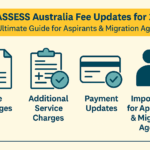Discover the University of Huddersfield, London: Your Gateway to Global Success
Are you seeking a postgraduate experience that combines academic excellence with vibrant city life? The University of Huddersfield, London (HL) is making waves for its
Unlock Your Potential in South Australia with the National Innovation Visa
Are you a researcher, entrepreneur, investor, or creative professional with a proven track record in your field? The South Australian nomination for the National Innovation
Your Strategic Roadmap to a German Student Visa
Germany is a world leader in engineering, technology, and research, offering an exceptional and often tuition-free education. To gain access to this academic excellence, you
Your Roadmap to a Successful French Student Visa Application
A French education offers a unique blend of academic tradition and modern innovation, set against a backdrop of unparalleled culture. To begin this exciting chapter,
The Essential Checklist for Your Canadian Study permit Application
Canada is celebrated for its world-class education system and vibrant, multicultural society. It is a top choice for students globally, but gaining entry requires a
Your Strategic Blueprint for a Successful UK Student Visa Application
The United Kingdom, with its centuries of academic prestige and dynamic cultural landscape, offers an unparalleled educational experience. However, before you can walk the hallowed
Your Strategic Guide to a Successful Australian Student Visa Application
Dreaming of studying in Australia? The vibrant cities, world-class universities, and unique culture wait. But before you can pack your bags, there’s one crucial hurdle:
The Heart of Your Journey: A Strategic Guide to Choosing Your Course Abroad
The decision to study abroad is exhilarating. But once the excitement settles, you face the most critical question of all: what will you actually study?
Blueprint for Your Global Future: Selecting the Right Study Destination
Choosing where to study abroad is more than just picking a spot on the map; it’s about designing the next chapter of your life. The
The Adventure of a Lifetime: A Realistic Look at Studying Abroad
Here at Sherin Overseas Education, we believe that choosing to study in a foreign country is one of the most powerful decisions a student can













